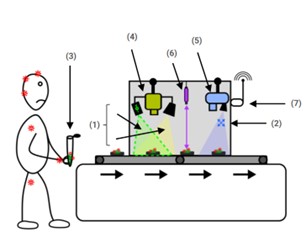Infectious diseases caused by pathogens can spread very rapidly and are increasingly difficult to treat, causing serious health problems in the world’s population. Therefore, rapid diagnosis is very important to stop the spread of disease-causing pathogens. The COVID-19 pandemic in 2020 highlighted the limitations of the existing technologies for rapid mass screening by detecting infectious pathogens in humans. This is especially important for mass transportation and events, and for situations such as the detection of biological threats at border controls, and the prevention of bioterrorism.
For this reason, researchers from the University of Sevilla and FISEVI have developed a fast and contactless technology that can be used for mass screening at a distance by measuring different properties of the scattered optical radiation. The main application of this technology is the non-invasive scanning of pathogens by analyzing saliva and other body accessible body fluids.
The researchers have developed a device and method for detecting, identifying, and quantifying pathogens at a distance present in different surfaces. The system includes the emission and recording of light beams, whose properties are modulated depending on the pathogen. The cameras and the optic sensor capture the data which can be processed internally by the device. A pathogen-specific numerical signature is formed for each pathogen on each medium and surface. This can be analyzed and compared with reference signatures using statistical and artificial intelligence algorithms.

The method has been tested for detecting and quantifying synthetic lentivirus and coronavirus-type viruses in fluid samples and also SARSCOV2 in humans. The method is protected by a Spanish Patent Application, published in 2021, and the device is also protected by a Spanish Patent Application, published in 2022.
Benefits:
- Easy and non-invasive.
- Potential to perform a concomitant analysis of multiple samples.
- The technology can be applied in several technical and industrial sectors, such as epidemiological surveillance and biosanitary control.
- The method of detection is fast, remote, and reagent-free.
- The technology can be implemented in various equipment, mobile units, and devices.
The represented institution is looking for feedback about the industry’s needs. The researchers would also be open to collaborating if the technology presented is of interest.
Institution: Universidad de Sevilla (US).
TRL: 3-4
Protection status: Patent Application
Financed: FIPSE
Contact: Marta Quintana / tech@viromii.com

